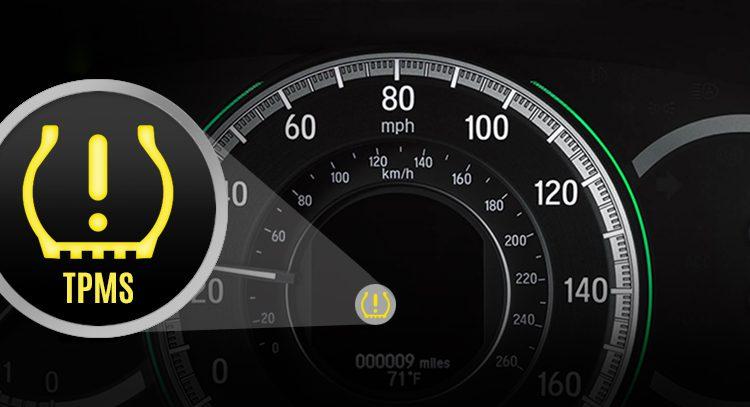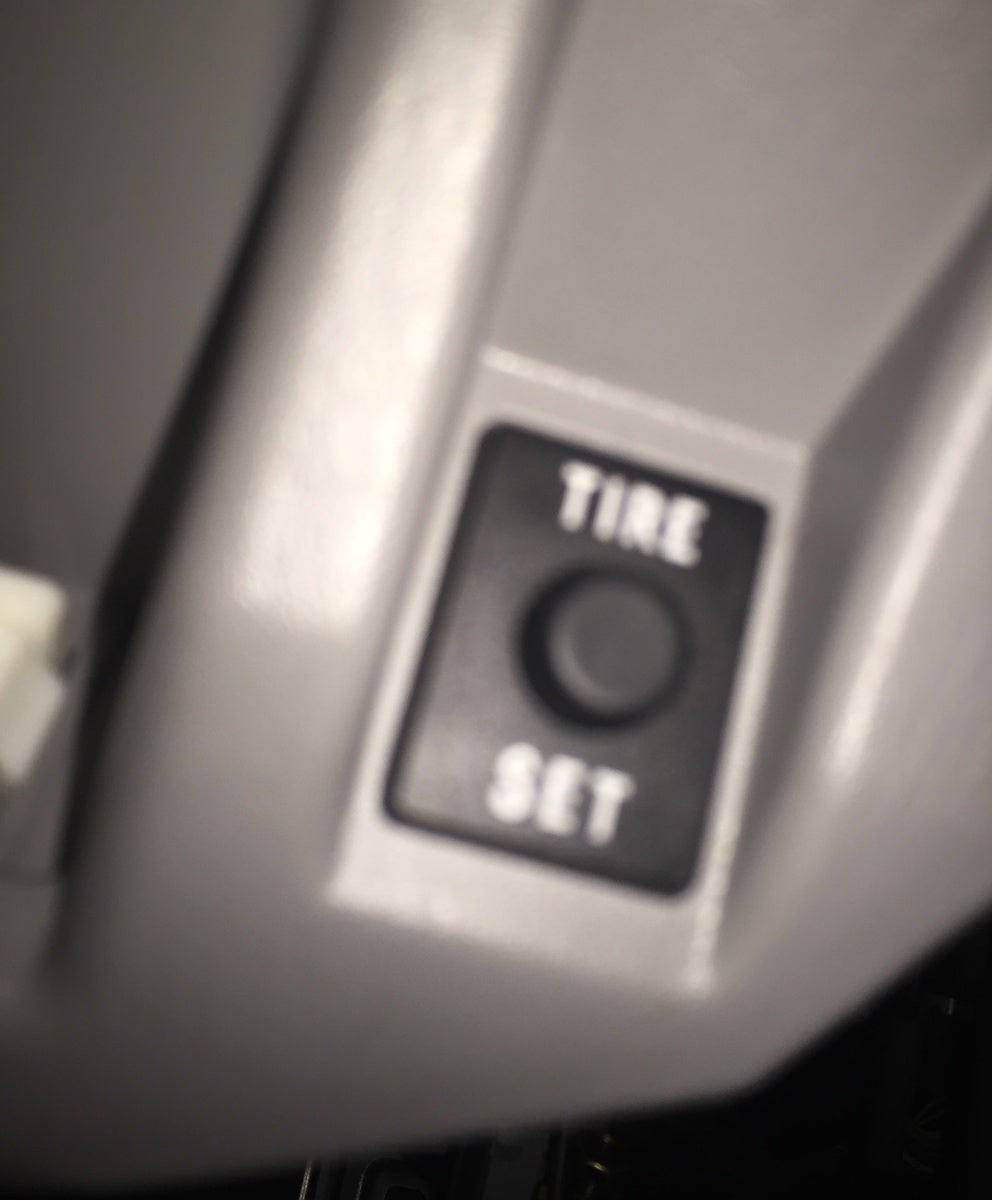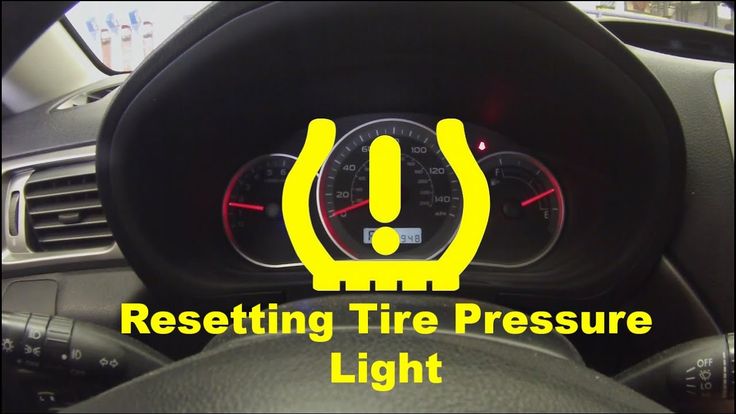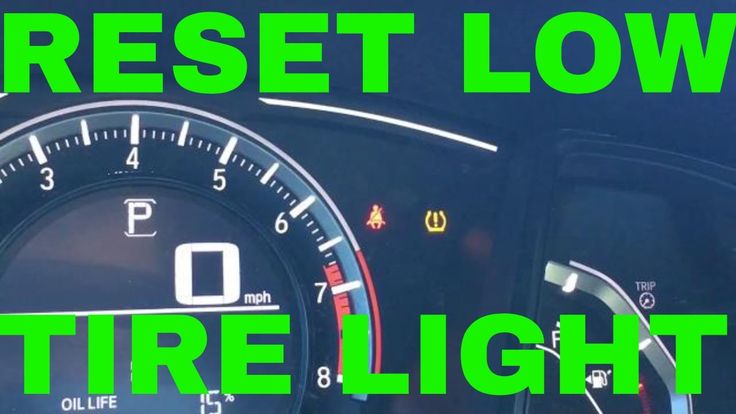Hide Show
Sell/Trade Us Your Car | Click Here To Learn More
Your tire pressure light provides a critical reminder to restore the pressure in your vehicle's tires when it gets low. You should only attempt to reset the light after first addressing the tire pressure in every tire. Once your tires are at the appropriate pressure, the light may go off on its own. If it doesn't go off right away, driving at 50 mph for about 10 minutes should help the tire pressure sensor reset.
If the tire pressure light is still on, there are a few more tricks you can try:
TPMS stands for Tire Pressure Monitoring System. The tire pressure light is one component of this electronic system, providing a visual alert when your tire pressure is low. The TPMS monitors tire pressure using either an indirect or direct method.
An indirect TPMS measures the rate of revolution for each wheel. If a wheel starts spinning faster than anticipated, the system signals to your vehicle's computer that something is amiss with the tire rotation, and your tire pressure light comes on. You must manually reset the monitor in an indirect TPMS system.
A direct TPMS uses pressure monitoring sensors in each tire to monitor tire pressure exactly. This is a more accurate alternative to an indirect TPMS system. The batteries inside these sensors will last for about 10 years. Direct TPMS systems reset automatically after tire inflation or rotation. You do need to have these sensors resynchronized when you get new tires, which requires a special tool.
Yes, cold weather will affect the air pressure in your tires. Your tires lose one or two pounds per square inch (PSI) for every 10 degrees that the temperature drops. Cold air condenses while warm air expands. Therefore, the colder air in your tires will take up less space in lower temperatures.
You may find that your TPMS light is only illuminated for a short time in the morning on particularly cold days. After about 20 minutes of driving, the air will often warm up and expand, restoring proper pressure in your tires. If the light stays on after 20 minutes on the road, you should add air to your tires as needed to restore the proper pressure. Low tire pressure is hazardous for your vehicle regardless of the cause.
If the light stays on after 20 minutes on the road, you should add air to your tires as needed to restore the proper pressure. Low tire pressure is hazardous for your vehicle regardless of the cause.
When the tire pressure monitor light is on, the first thing you should do is check the pressure in each of your tires, including the spare. Check the manufacturer's recommendation to determine the appropriate pressure for each tire. This is typically between 30 and 35 PSI but may vary. You should measure tire pressure when the tires are cold, which means they have not been driven in the last three hours.
To check the pressure, simply unscrew the valve cap and insert a tire gauge into the valve stem. The gauge will provide a clear reading. Replace the valve cap when you're finished. If your tires are all at the appropriate pressure, there's a malfunction with your TPMS. Bring your vehicle to an authorized dealership service center to diagnose and resolve the issue.
If the tire pressure monitor light is on, you should check your tire pressure as soon as possible. Low tire pressure creates a serious hazard on the road. According to the National Highway Traffic Safety Administration, 738 people died in tire-related crashes in 2017. When tire pressure is low, the tire has more contact with the road. This may cause the tire to overheat, leading to tread separation, excessive tire wear, or a blowout.
Low tire pressure also wreaks havoc on your fuel efficiency. You can save up to 11 cents per gallon simply by keeping your tires properly inflated. You'll also save money on tire replacements with adequate inflation. Keeping your tires properly inflated can add 4,700 miles to the tire's average lifespan.
The tire pressure monitor light gives you valuable information and should not be ignored.
You do not necessarily need to have your TPMS sensors replaced with new tires, but this is a good time to check them and make sure they're still in good condition. If you have an indirect TPMS system, your mechanic will need to manually reset the sensors after changing your tires. If you have a direct TPMS system, no additional maintenance is required to reset the system.
If you have an indirect TPMS system, your mechanic will need to manually reset the sensors after changing your tires. If you have a direct TPMS system, no additional maintenance is required to reset the system.
A new TPMS system will typically last for about 10 years before the batteries run out. If you have an older vehicle, you may need new sensors every five or six years. Your mechanic can advise you on the best time to replace TPMS sensors for your vehicle. When new sensors are installed, the system must relearn the location of each tire, which requires a detailed series of technical procedures. You should leave this task to a professional.
If you need tire service for your Toyota, come to Kings Toyota for prompt, reliable service. Our highly-trained technicians are equipped to assist with any type of tire issue, whether you need new tires or have a malfunctioning tire pressure sensor light. Make your appointment today.
First Name*
Last Name*
Contact Me by*
EmailPhone
Unsure how to reset the tire pressure light on your Ford after inflating the tires? Your tire pressure monitoring system (TPMS) is critical to ensuring your safety, and it’s important to pay attention to its alerts. However, if the light remains on after addressing any issues, then you can follow these steps from Jim Hudson Ford to turn the light off and learn more about the purpose of the TPMS in the process. And remember, if issues persist, you can always bring your vehicle to the service center at Jim Hudson Ford near Chapin.
However, if the light remains on after addressing any issues, then you can follow these steps from Jim Hudson Ford to turn the light off and learn more about the purpose of the TPMS in the process. And remember, if issues persist, you can always bring your vehicle to the service center at Jim Hudson Ford near Chapin.
If the TPMS light ignites on your dashboard, then check the tire pressure in each tire and inflate them as necessary to the recommended PSI. This figure is located inside the driver’s side door or in your owner’s manual. If reinflation doesn’t work, try out these actions:
 Release the button, start the ignition, and the light should be off.
Release the button, start the ignition, and the light should be off.What does a flashing tire pressure light mean? This may indicate that the tire pressure sensors need replacement batteries, or that there is an issue with one of the sensors in general. To diagnose the actual problem, schedule service near Irmo at Jim Hudson Ford. Our technicians can get things figured out in no time!
Having your TPMS light on isn't a reason to worry. There are many ways to turn it off, and Columbia-area drivers can always contact Jim Hudson Ford for more advice on all service-related questions, including how to check car oil or how to unlock a steering wheel.
There are many ways to turn it off, and Columbia-area drivers can always contact Jim Hudson Ford for more advice on all service-related questions, including how to check car oil or how to unlock a steering wheel.
Although every reasonable effort has been made to ensure the accuracy of the information contained on this site, absolute accuracy cannot be guaranteed. This site, and all information and materials appearing on it, are presented to the user "as is" without warranty of any kind, either express or implied. All vehicles are subject to prior sale. Price does not include applicable tax, title, and license charges. ‡Vehicles shown at different locations are not currently in our inventory (Not in Stock) but can be made available to you at our location within a reasonable date from the time of your request, not to exceed one week.
Although every reasonable effort has been made to ensure the accuracy of the information contained on this site, absolute accuracy cannot be guaranteed. This site, and all information and materials appearing on it, are presented to the user "as is" without warranty of any kind, either express or implied. All vehicles are subject to prior sale. Price does not include applicable tax, title, and license fees. ‡Vehicles shown at different locations are not currently in our inventory (Not in Stock) but can be made available to you at our location within a reasonable date from the time of your request, not to exceed one week.
This site, and all information and materials appearing on it, are presented to the user "as is" without warranty of any kind, either express or implied. All vehicles are subject to prior sale. Price does not include applicable tax, title, and license fees. ‡Vehicles shown at different locations are not currently in our inventory (Not in Stock) but can be made available to you at our location within a reasonable date from the time of your request, not to exceed one week.
FLINTMANUTION
Content
 The problem lies in the low accuracy of the device.
The problem lies in the low accuracy of the device. Its error can reach 30%, that is, about a third of the system operations, an error. While half of the drivers have come to terms with the imperfections of their beloved SUV, the other half are desperately trying to fix it, bumping into an insurmountable obstacle.
The fact is that it is impossible to turn off the sensors. We'll have to look for other ways to remedy the situation. What exactly? Now we'll tell you.
The most obvious way to reset a tire pressure sensor error is to check the condition of the tires. Yes, the error in the operation of devices is extremely high, but in most cases they still signal a real problem.
If the insidious light comes on while driving, stop at a convenient authorized place and make sure the tire is properly inflated. To do this, it is better to use a pressure gauge, because it is not so easy to determine by eye where the air is released.
Then proceed according to the situation. Try inflating the tire to the standard level, and then start the car and drive at normal speed for several kilometers.
Hyundai Creta tire pressure error will reset by itself, without requiring additional expert intervention. The miracle did not happen, or was the tire completely in order, but the light continues to burn, distracting and annoying? Then you have to be cunning and here are the main ways:
 Remove the battery terminals for a couple of minutes, and then put them back in place.
Remove the battery terminals for a couple of minutes, and then put them back in place. Important note: If you decide to remove the sensors from the discs, in the hope of getting rid of a regular error, then you will not come to the desired result. The light will remain on even if there are no devices.
There is another way to disable TPMS on your Hyundai Creta. Experts call it initialization and it is mainly used when changing wheels between seasons. Proceed step by step:
If none of the above methods helped, the light remains on, and you are absolutely sure that the tire pressure is at the level recommended by the manufacturer, you will have to go to a service center.
There, using special software and a scanner, the master will be able to forcibly shut down the system or reflash it in order to finally rid the driver of the problem.
Important note: Even a specialist in a service center does not disable tire pressure sensors. He only makes sure that the annoying signal on the dashboard does not turn on.
Sometimes a frequent error may indicate that the device itself is broken. In this case, resetting errors on the Hyundai Creta will not help, because it will not fix the breakdown. Try changing the TPMS to a new one. You can do it yourself, but you will have to tinker.
The tire pressure sensors in the Korean crossover are hidden directly inside the wheels, in the tire cavity. So for replacement, you will have to dismantle each of them.
The best option would be to contact a specialized service center, but if you prefer to handle it yourself, then at least call a friend to help you, who will hold the disk.
But there is no need to register new devices after their installation. Just drive a few kilometers at the same speed and the information will begin to be transmitted to the head unit.
At the same time, no one will guarantee that beginners will not start making mistakes and you will not have to reset the Hyundai Creta tire pressure sensor. After all, you remember about the 30 percent error?
However, we do not recommend trying to disable the pressure control. Better try to get used to it. Factory-installed sensors on the Hyundai Creta are one of the basic security systems designed to protect against accidents, rapid tire wear and other troubles.
Vladimir, 55 years old (Yaroslavl)
What is the standard pressure for Hyundai Crete provided by the manufacturer and does it depend on the type of engine?
This indicator does not depend on the vehicle equipment. In a normally loaded car, tire pressure should be 2.3 bar, and in crossovers with a maximum load, 2.5 bar. The manufacturer's recommendations are displayed on a sticker located on the front of the driver's door. You can verify this for yourself.
In a normally loaded car, tire pressure should be 2.3 bar, and in crossovers with a maximum load, 2.5 bar. The manufacturer's recommendations are displayed on a sticker located on the front of the driver's door. You can verify this for yourself.
Sergey, 29 years old (Abakan)
How does the level of tire pressure depend on weather conditions? I noticed that the malfunction from the sensors pops up only in the winter period.
The lower the air temperature, the lower the tire pressure drops. Therefore, in climates with cold winters, it is recommended to inflate tires a little more than the manufacturer requires. But we are talking about really low temperatures (from -20 degrees and less).
Dmitry, 25 years old (Barnaul)
How often can a Hyundai Creta error reset be done so that the head unit does not refuse to work?
There are no specific recommendations for this. But if you have to reset too often, you should think about the causes of the problem and deal with it once. Perhaps a specific sensor is naughty due to a breakdown? Seek help from experts and clarify this point.
Perhaps a specific sensor is naughty due to a breakdown? Seek help from experts and clarify this point.
Alexander
Ask a question
Owner of Hyundai Creta. 10 years behind the wheel, 15 years in the automotive field!
Subscribe to our channel in Yandex Zen - HyundaiCreta.ru! Get news first hand!
TPMS or Tire Pressure Monitoring System is a set of equipment commonly found in modern vehicles. Its main job is to alert you if there are problems with tire pressure. For example, one tire has lost pressure - in this case it is not safe to drive, but the system will inform you about this, and you can inflate the wheel to avoid steering problems.
But sometimes the system does not work correctly. Some sensors may fail or the system needs to be rebooted. In this case, you may see a blinking or simply lit tire pressure error indicator on the dashboard. Resetting the pressure monitoring system will help you solve the problem if the sensor is working.
Resetting the pressure monitoring system will help you solve the problem if the sensor is working.
Please note that different vehicles may have different TPMS reset methods, so you may need to try several of them before you know the most effective one.
Initially, you will just need to hold the tire pressure sensor reset button for a few seconds until the pressure indicator flashes three times and then goes out. But sometimes it doesn't help much. So we found other ways to calm down the pressure control system.
First, locate the TPMS reset button, which is usually located somewhere under the steering wheel. Start the car, press and hold the button for 3 seconds. Then drive at a speed of 80 km/h for approximately 10 minutes. Of course, you will need to find a suitable track for this. Steady driving is an important part of resetting tire pressure sensors this way. Of course, before this operation, you will need to inflate the tires to the required pressure.
In some vehicles, you will need to drive on any road and at any speed for 20 minutes after resetting the sensors, as long as you do not turn off the engine.
So, start the car, press the reset button and hold it for three seconds. Do not turn off the engine until 20 minutes have passed. You can drive or just let the engine idle for 20 minutes. This method of resetting pressure sensors should work for most vehicles. Again, inflate the tires to the correct pressure before resetting the system.
If the simple methods don't work with your machine, try another method. Start the engine so that the tire pressure monitoring system can register the changes. Then inflate the tire 0.2 bar above the recommended level. After a minute, completely deflate the tire. Wait one more minute to reset the sensors. Then inflate the tire to the optimum pressure level and let the engine run for another minute. The indicator should stop flashing.
The indicator should stop flashing.
The idea is to reset the entire engine electronics system by cutting off the power supply from the battery. First, make sure all tires are at the correct pressure. After that, turn off the engine, open the hood and disconnect both terminals from the battery. Wait 10-15 minutes. Reconnect the battery and turn on the ignition to check if the indicator lamp goes out.
If the above methods do not work with your vehicle, there is another option. Find a manual for your car or open a forum thread that talks about resetting tire pressure sensors in your car. Look for the combination of steps the manufacturer recommends to reset the TPMS system. Sometimes the combination can be quite strange and even complex.
If all methods fail and the error light continues to flash, the problem may be with the sensors. It is the blinking signal of the tire pressure lamp that often indicates a sensor malfunction. If there is a problem with tire pressure, usually the light will just come on and not blink.
It is the blinking signal of the tire pressure lamp that often indicates a sensor malfunction. If there is a problem with tire pressure, usually the light will just come on and not blink.
This means that if the light is flashing, one of the sensors may be faulty. Replacing the element is not so easy because it is under the tire. The tire must be removed from the rim to replace the sensor.
After replacement, you will still need to reset the pressure control system for the new sensor to work. Otherwise, the indicator will flash or light up.
Where is the reset button for the tire pressure sensors?
The button is often located directly below the steering wheel. But there may be different options. If you don't find the TPMS reset button there, look around the steering wheel - it should be somewhere in this area.
Difficult to say for all vehicles, but for most vehicles, the travel time before resetting the tire pressure monitoring system should be at least 10-15 minutes. If you turn off the engine earlier than 10 minutes after pressing the reset button, the TPMS will still send some error signals the next time the engine is started.
If you turn off the engine earlier than 10 minutes after pressing the reset button, the TPMS will still send some error signals the next time the engine is started.
Drivers sometimes upgrade tires and wheels to larger ones and want their stock pressure control modules to work properly. The problem is that larger or flat-ride tires will have a different optimum pressure level, so the original gauges will always show an error on your dashboard.
One way to solve the problem is to buy other sensors tuned to the desired level of tire pressure. Another way is to reset the control system in your car at the service station. Just check which option will be cheaper for you.
It's hard to say why manufacturers haven't added an option to automatically reset tire pressure sensors in cars. In most post-2015 vehicles, the TPMS is autonomous enough that it won't bother you much with reset requests.